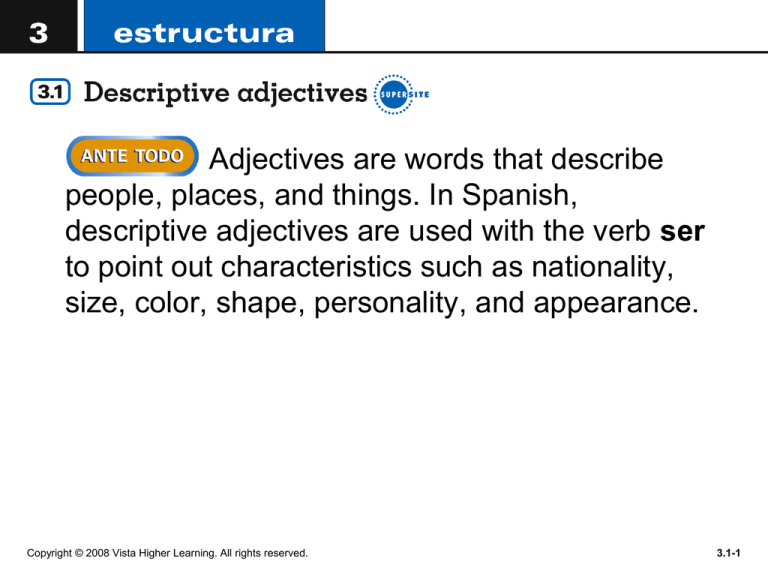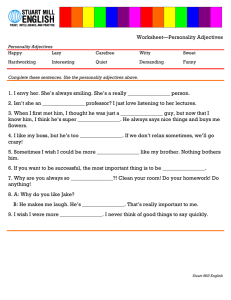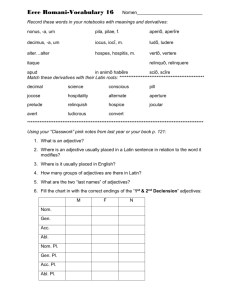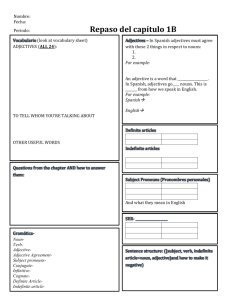
Adjectives are words that describe
people, places, and things. In Spanish,
descriptive adjectives are used with the verb ser
to point out characteristics such as nationality,
size, color, shape, personality, and appearance.
Copyright © 2008 Vista Higher Learning. All rights reserved.
3.1-1
Forms and agreement of adjectives
Copyright © 2008 Vista Higher Learning. All rights reserved.
3.1-2
Adjectives that end in -o have four different forms. The
feminine singular is formed by changing the -o to -a.
The plural is formed by adding -s to the singular forms.
Copyright © 2008 Vista Higher Learning. All rights reserved.
3.1-3
Adjectives that end in -e or a consonant have
the same masculine and feminine forms.
Copyright © 2008 Vista Higher Learning. All rights reserved.
3.1-4
Adjectives that end in -or are variable in both
gender and number.
Copyright © 2008 Vista Higher Learning. All rights reserved.
3.1-5
Adjectives that refer to nouns of different genders use
the masculine plural form.
Copyright © 2008 Vista Higher Learning. All rights reserved.
3.1-6
Adjectives of nationality
Unlike in English, Spanish adjectives of nationality
are not capitalized. Proper names of countries,
however, are capitalized.
Copyright © 2008 Vista Higher Learning. All rights reserved.
3.1-7
Adjectives of nationality are formed like other
descriptive adjectives. Those that end in -o
form the feminine by changing the -o to -a.
The plural is formed by adding an -s to the
masculine or feminine form.
Copyright © 2008 Vista Higher Learning. All rights reserved.
3.1-8
Adjectives of nationality that end in -e have
only two forms, singular and plural.
Copyright © 2008 Vista Higher Learning. All rights reserved.
3.1-9
Adjectives of nationality that end in a
consonant form the feminine by adding -a.
Copyright © 2008 Vista Higher Learning. All rights reserved.
3.1-10
Adjectives of nationality which carry an
accent mark on the last syllable drop it in the
feminine and plural forms.
Copyright © 2008 Vista Higher Learning. All rights reserved.
3.1-11
Position of adjectives
Descriptive adjectives and adjectives of nationality
generally follow the nouns they modify.
Copyright © 2008 Vista Higher Learning. All rights reserved.
3.1-12
Unlike descriptive adjectives, adjectives of
quantity are placed before the modified noun.
Copyright © 2008 Vista Higher Learning. All rights reserved.
3.1-13
Bueno/a and malo/a can be placed before or
after a noun. When placed before a
masculine singular noun, the forms are
shortened: bueno
buen; malo
mal.
Copyright © 2008 Vista Higher Learning. All rights reserved.
3.1-14
When grande appears before a singular
noun, it is shortened to gran, and the
meaning of the word changes: gran = great
and grande = big, large.
Copyright © 2008 Vista Higher Learning. All rights reserved.
3.1-15
Provide the appropriate forms of the adjectives. The
first item in each group has been done for you.
simpático
alemán
1. Mi hermano es ________.
simpático
alemán
1. Hans es ________.
2. La profesora Martínez es _____.
2. Mis primas son _____.
3. Rosa y Teresa son _____.
3. Marcus y yo somos _____.
4. Nosotros somos _____.
4. Mi tía es _____.
Copyright © 2008 Vista Higher Learning. All rights reserved.
3.1-16
Provide the appropriate forms of the adjectives. The
first item in each group has been done for you. (cont’d)
difícil
guapo
1. La química es _______.
difícil
1. Su esposo es _______.
guapo
2. El curso es _____.
2. Mis sobrinas son _____.
3. Las pruebas son _____.
3. Los padres de ella son _____.
4. Los libros son _____.
4. Marta es _____.
Copyright © 2008 Vista Higher Learning. All rights reserved.
3.1-17







